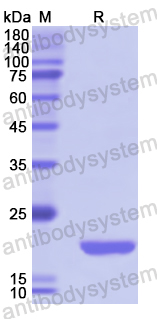Catalog No.
YHG81801
Expression system
E. coli
Species
Homo sapiens (Human)
Protein length
Ala837-Lys996
Predicted molecular weight
20.02 kDa
Nature
Recombinant
Endotoxin level
Please contact with the lab for this information.
Purity
>90% as determined by SDS-PAGE.
Accession
Q14527
Applications
ELISA, Immunogen, SDS-PAGE, WB, Bioactivity testing in progress
Form
Lyophilized
Storage buffer
Lyophilized from a solution in PBS pH 7.4, 0.02% NLS, 1mM EDTA, 4% Trehalose, 1% Mannitol.
Reconstitution
Reconstitute in sterile water for a stock solution. A copy of datasheet will be provided with the products, please refer to it for details.
Shipping
In general, proteins are provided as lyophilized powder/frozen liquid. They are shipped out with dry ice/blue ice unless customers require otherwise.
Stability and Storage
Use a manual defrost freezer and avoid repeated freeze thaw cycles. Store at 2 to 8°C for frequent use. Store at -20 to -80°C for twelve months from the date of receipt.
Alternative Names
HIP116, RING-type E3 ubiquitin transferase HLTF, SNF2L3, DNA-binding protein/plasminogen activator inhibitor 1 regulator, HLTF, Sucrose nonfermenting protein 2-like 3, ZBU1, SWI/SNF-related matrix-associated actin-dependent regulator of chromatin subfamily A member 3, Helicase-like transcription factor, RING finger protein 80, SMARCA3, HIP116A, RNF80
The DNA damage tolerance factor Rad5 and telomere replication., PMID:40418329
Identification of hub genes related to DNA damage response in asthma via combinative bioinformatics strategy., PMID:40288048
Identification of multiple hypoxia-independent triggers of upper airway long-term facilitation in a rat model of upper airway motor plasticity., PMID:40067835
LINC01088 prevents ferroptosis in glioblastoma by enhancing SLC7A11 via HLTF/USP7 axis., PMID:40000422
Acetyltransferase NAT10 inhibits T-cell immunity and promotes nasopharyngeal carcinoma progression through DDX5/HMGB1 axis., PMID:39939141
CBX3 Downregulates HLTF to Activate PI3K/AKT Signaling Promoting Cholangiocarcinoma., PMID:39601498
Profound synthetic lethality between SMARCAL1 and FANCM., PMID:39510066
Computational study of the HLTF ATPase remodeling domain suggests its activity on dsDNA and implications in damage tolerance., PMID:39491691
Elucidating the roles of SOD3 correlated genes and reactive oxygen species in rare human diseases using a bioinformatic-ontology approach., PMID:39480826
Senataxin and DNA-PKcs Redundantly Promote Non-Homologous End Joining Repair of DNA Double Strand Breaks During V(D)J Recombination., PMID:39386666
HLTF/SERPINE1 Axis Plays a Crucial Pro-Oncogenic Role in the Progression from Cervical Precancerous Lesions to Cervical Carcinoma in vitro., PMID:39348822
Disparate requirements for RAD54L in replication fork reversal., PMID:39315725
HLTF resolves G4s and promotes G4-induced replication fork slowing to maintain genome stability., PMID:39142279
RTEL1 helicase counteracts RAD51-mediated homologous recombination and fork reversal to safeguard replicating genomes., PMID:39116203
HLTF disrupts Cas9-DNA post-cleavage complexes to allow DNA break processing., PMID:38987539
The fork remodeler helicase-like transcription factor in cancer development: all at once., PMID:38851303
Chromatin context-dependent regulation and epigenetic manipulation of prime editing., PMID:38608704
The levels of p53 govern the hierarchy of DNA damage tolerance pathway usage., PMID:38321962
DTX2 promotes glioma development via regulation of HLTF., PMID:38163902
LD block disorder-specific pleiotropic roles of novel CRHR1 in type 2 diabetes and depression disorder comorbidity., PMID:38092990
Exploring RAD18-dependent replication of damaged DNA and discontinuities: A collection of advanced tools., PMID:38072328
Spatial regulation of DNA damage tolerance protein Rad5 interconnects genome stability maintenance and proteostasis networks., PMID:38055836
Helicase-like transcription factor (HLTF)-deleted CDX/TME model of colorectal cancer increased transcription of oxidative phosphorylation genes and diverted glycolysis to boost S-glutathionylation in lymphatic intravascular metastatic niches., PMID:37682902
Helicase-like transcription factor (Hltf)-deletion activates Hmgb1-Rage axis and granzyme A-mediated killing of pancreatic β cells resulting in neonatal lethality., PMID:37624843
Disparate requirements for RAD54L in replication fork reversal., PMID:37546955
The helicase-like transcription factor redirects the autophagic flux and restricts human T cell leukemia virus type 1 infection., PMID:37487091
Upregulation of helicase-like transcription factor predicts poor prognosis and facilitates hepatocellular carcinoma progression., PMID:37227687
Development and validation of novel prognostic models for zinc finger proteins-related genes in soft tissue sarcoma., PMID:37100454
Arginine shortage induces replication stress and confers genotoxic resistance by inhibiting histone H4 translation and promoting PCNA ubiquitination., PMID:36961817
Degradation of helicase-like transcription factor (HLTF) by β-TrCP promotes hepatocarcinogenesis via activation of the p62/mTOR axis., PMID:36822623
HLTF promotes hepatocellular carcinoma progression by enhancing SRSF1 stability and activating ERK/MAPK pathway., PMID:36670110
Rad5 participates in lesion bypass through its Rev1-binding and ubiquitin ligase domains, but not through its helicase function., PMID:36533078
PARP1 recruits DNA translocases to restrain DNA replication and facilitate DNA repair., PMID:36512630
The transcriptional coactivator Eya1 exerts transcriptional repressive activity by interacting with REST corepressors and REST-binding sequences to maintain nephron progenitor identity., PMID:36130284
Strand annealing and motor driven activities of SMARCAL1 and ZRANB3 are stimulated by RAD51 and the paralog complex., PMID:35801922
Rad5 and Its Human Homologs, HLTF and SHPRH, Are Novel Interactors of Mismatch Repair., PMID:35784486
TT-pocket/HIRAN: binding to 3'-terminus of DNA for recognition and processing of stalled replication forks., PMID:35662338
Mechanistic Insights into the Multiple Activities of the Rad5 Family of Enzymes., PMID:35398319
Active DNA damage eviction by HLTF stimulates nucleotide excision repair., PMID:35271816
PRRSV Non-Structural Proteins Orchestrate Porcine E3 Ubiquitin Ligase RNF122 to Promote PRRSV Proliferation., PMID:35216017
Identification of Key Pathways and Establishment of a Seven-Gene Prognostic Signature in Cervical Cancer., PMID:35154316
Characterization of Epigenomic Alterations in HPV16+ Head and Neck Squamous Cell Carcinomas., PMID:35064062
The Rad5 Helicase and RING Domains Contribute to Genome Stability through their Independent Catalytic Activities., PMID:34990655
Cockayne syndrome group B protein regulates fork restart, fork progression and MRE11-dependent fork degradation in BRCA1/2-deficient cells., PMID:34871413
BRCA2 associates with MCM10 to suppress PRIMPOL-mediated repriming and single-stranded gap formation after DNA damage., PMID:34645815
A role for Rad5 in ribonucleoside monophosphate (rNMP) tolerance., PMID:34407997
Fission yeast Rad8/HLTF facilitates Rad52-dependent chromosomal rearrangements through PCNA lysine 107 ubiquitination., PMID:34292936
Helicase-like transcription factor-deletion from the tumor microenvironment in a cell line-derived xenograft model of colorectal cancer reprogrammed the human transcriptome-S-nitroso-proteome to promote inflammation and redirect metastasis., PMID:34010296
Making Choices: DNA Replication Fork Recovery Mechanisms., PMID:33967572
Structure of Rad5 provides insights into its role in tolerance to replication stress., PMID:33860087

